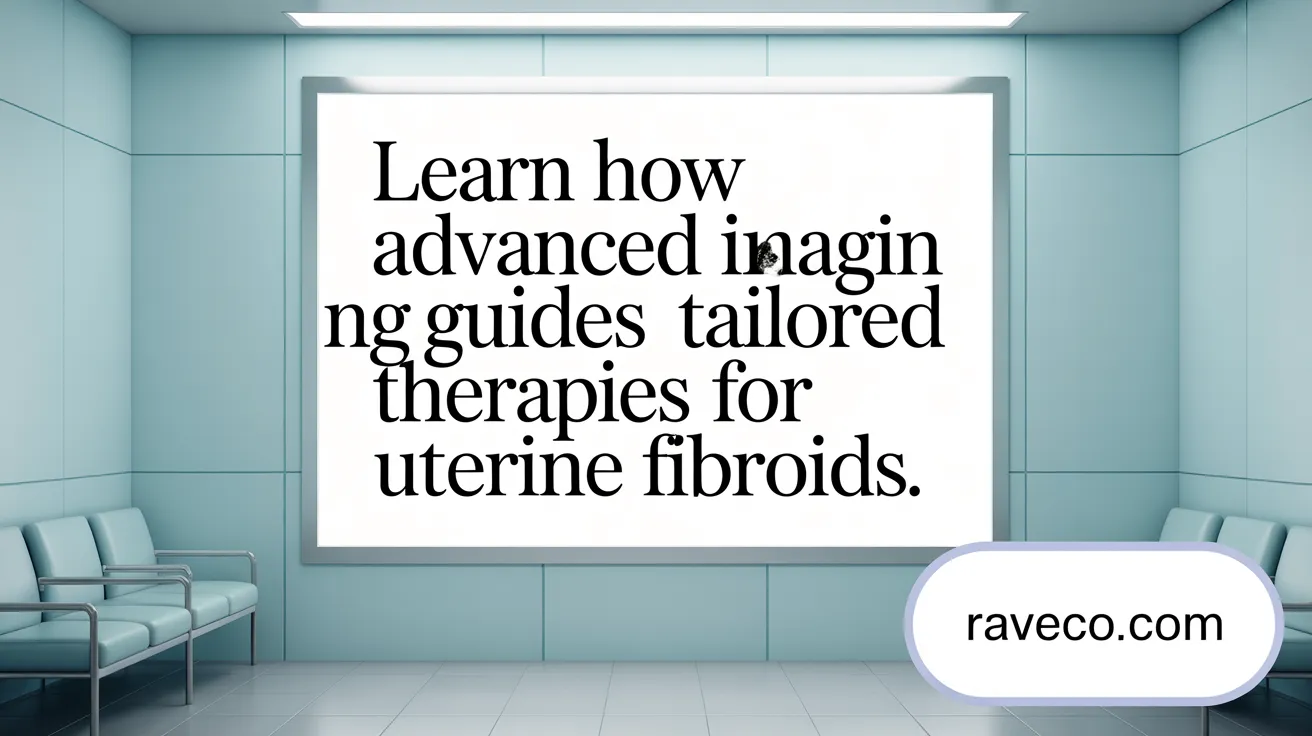How Genetic Counseling Shapes Informed Choices in Prenatal Care

Understanding Fibroids and the Need for Innovation
Uterine fibroids are noncancerous growths affecting up to 80% of women by age 50, often causing symptoms such as heavy menstrual bleeding, pelvic pain, and fertility issues. Traditionally, treatment options ranged from hormonal medications to invasive surgeries like hysterectomy. However, emerging minimally invasive and nonsurgical treatments are transforming fibroid management by preserving the uterus, reducing recovery times, and addressing symptom relief more effectively. This article explores these innovative therapies, helping patients make informed decisions about their care.
Comprehensive Diagnosis: The Foundation of Tailored Treatment

How are uterine fibroids diagnosed?
Uterine fibroids are frequently detected during Pelvic examination for uterine fibroids when a healthcare provider feels irregularities or changes in the shape of the uterus. This initial step often raises suspicion of fibroids, especially in patients presenting symptoms or undergoing gynecologic exams for other reasons.
Methods of Diagnosing Uterine Fibroids
Ultrasound diagnosis of fibroids remains the frontline imaging technique for confirming the presence of fibroids. Both transabdominal and transvaginal ultrasound modalities are used to detect fibroids, providing important details about their size and location within the uterus. Because ultrasound is widely available, cost-effective, and noninvasive, it is typically the first choice for evaluation.
When ultrasound images are insufficient for detailed assessment, more advanced imaging technologies become important. MRI imaging in fibroid assessment offers high-resolution images that visualize fibroid number, size, exact position, and type (such as intramural, submucosal, or subserosal). This information is crucial for developing an individualized treatment plan.
Other specialized diagnostic techniques include Hysterosonography to detect submucosal fibroids, where saline is infused to enhance visualization of submucosal fibroids inside the uterine cavity. Hysterosalpingography imaging for fibroids uses dye and X-ray imaging to assess uterine cavity shape and fallopian tube function, sometimes revealing fibroids. Hysteroscopy for fibroid examination and removal involves inserting a lighted instrument into the uterus, allowing direct visualization and potential removal of certain fibroids.
Role of Imaging Technologies
Imaging not only confirms fibroid presence but also helps characterize their features. Knowing fibroid size, number, and location is critical for choosing appropriate therapies—from Watchful waiting for asymptomatic fibroids to Medication treatment for fibroids or Minimally invasive fibroid treatments. For instance, detailed MRI helps surgeons plan Myomectomy surgical removal of fibroids or guides less invasive procedures like Focused ultrasound therapy or Transvaginal radiofrequency ablation.
Importance of Diagnosis for Treatment Planning
Accurate diagnosis informs personalized treatment, balancing symptom management, fertility considerations, and patient preferences. For women desiring pregnancy, knowing fibroid location aids in selecting fibroid removal surgery preserving uterus. In cases with minimal or no symptoms, Watchful waiting for asymptomatic fibroids may be recommended. In contrast, large or symptomatic fibroids require tailored interventions. Ultimately, comprehensive diagnosis ensures the safest, most effective management for each patient.
Minimally Invasive Procedures Offering Uterus Preservation

What are the modern minimally invasive treatments for fibroids?
Several advanced minimally invasive fibroid treatments provide effective symptom relief while preserving the uterus, making them appealing for women seeking to avoid surgery or maintain fertility.
Radiofrequency Ablation Techniques
Transcervical radiofrequency ablation, using systems like Sonata, delivers targeted ultrasound-guided radiofrequency energy through the cervix. This energy heats and shrinks fibroids without incisions or stitches. Procedure times range from 15 minutes to an hour, with most patients experiencing significant symptom improvement within three months and high satisfaction rates. Another option, laparoscopic radiofrequency ablation (such as the Acessa system), uses small abdominal incisions to deliver heat therapy to fibroids, offering quick recovery and minimal pain.
Uterine Fibroid Embolization (UFE)
UFE is an outpatient procedure where tiny particles are injected via catheter into the arteries feeding fibroids. This blocks their blood supply, causing fibroid shrinkage. It typically allows a faster recovery than surgery, with most patients resuming normal activities within a week. However, there is a risk of premature menopause, especially in women over 45. UFE is generally suitable for women who wish to preserve their uterus but may have concerns regarding future fertility.
Focused Ultrasound Surgery (FUS)
FUS is a noninvasive method that uses MRI-guided high-energy ultrasound waves to precisely heat and destroy fibroid tissue without incisions. It offers quick symptom relief and fast recovery, with fertility preservation potential. However, FUS requires longer treatment sessions and is limited by fibroid size and location.
Benefits and Risks
Minimally invasive fibroid treatments reduce hospital stays, postoperative pain, and recovery time compared to traditional surgeries like myomectomy and hysterectomy. They also preserve the uterus, an important consideration for many patients. Risks vary by procedure; for instance, UFE carries some risk of premature ovarian failure, and long-term fertility data for certain techniques like radiofrequency ablation remain limited. Careful patient selection and consultation with healthcare providers are essential to optimize outcomes.
These modern treatments represent significant advancements, offering women less invasive, uterus-sparing options with high rates of symptom relief and quicker returns to daily life.
Surgical Advances: Myomectomy and Beyond

What surgical options exist for fibroid treatment?
Surgical treatment for uterine fibroids mainly involves two procedures: myomectomy surgical removal of fibroids and hysterectomy surgical removal of uterus.
Myomectomy is the surgical removal of fibroids while preserving the uterus, making it an ideal choice for women who wish to have children in the future. This procedure can be performed using different approaches including laparoscopic fibroid treatment, robotic-assisted, or traditional open abdominal surgery, depending on fibroid size, number, and location. Laparoscopic and robotic myomectomies are minimally invasive, yielding shorter recovery times and less scarring.
Hysterectomy involves the complete removal of the uterus and is the definitive cure for fibroids, as it eliminates the possibility of recurrence. However, this surgery ends fertility and is usually reserved for women who no longer desire pregnancy or have completed childbearing.
Hysterectomy considerations
While hysterectomy for fibroids is effective in resolving fibroid-related symptoms, it comes with considerations such as longer recovery, potential impact on hormonal balance if ovaries are removed, and psychological effects. It is commonly recommended when fibroids are large, multiple, or when other treatments have failed.
Risks of morcellation
Morcellation is a technique sometimes used during myomectomy or hysterectomy to remove fibroids in smaller pieces through small incisions. However, it poses a risk of spreading undiagnosed cancerous cells, especially leiomyosarcoma, if present. Due to this risk, the FDA advises caution or recommends against power morcellation in most cases, particularly in women approaching menopause. See more on risks of morcellation in fibroid surgery.
Impact on fertility
Among surgical options, myomectomy surgery details is preferred for women wishing to maintain or improve fertility, as it removes fibroids but preserves the uterus. Hysterectomy, by contrast, eliminates all chances for pregnancy. Post-myomectomy, patients may be advised to wait several months before attempting conception. Despite surgery, fibroids can recur, so ongoing monitoring may be necessary.
This range of surgical approaches allows personalized treatment balancing symptom relief with fertility desires and risk management.
Innovative Medical Therapies and Emerging Treatments
What new medical treatments are available for fibroids?
Recent advancements in medical therapies for fibroids offer promising symptom relief and management options beyond traditional surgery. Two FDA-approved medications, Myfembree and Oriahnn, have been developed to reduce heavy menstrual bleeding by lowering hormone levels. These once-daily treatments work by targeting hormone pathways to control symptoms effectively over longer periods.
GnRH agonists and antagonists represent another class of medical therapies that temporarily shrink fibroids by inducing a menopause-like hormonal state. While effective in reducing fibroid size and bleeding, their use is often limited to short-term due to side effects like hot flashes and potential bone loss.
What experimental treatments are emerging?
Innovative research is exploring the potential of collagenase, an enzyme that breaks down collagen within fibroid tissue. By combining collagenase with a thermosensitive gel known as LiquoGel™, this experimental treatment aims to locally degrade fibroid collagen in a minimally invasive manner. Administered in outpatient settings, it could offer targeted therapy with fewer systemic effects than current treatments. However, this approach remains in preclinical and early research phases, with clinical trials awaited before widespread use. For more details, see engineering smart therapeutics: innovative uterine fibroid treatment.
Advantages and limitations of medical options
Medical therapies for fibroids primarily serve to alleviate symptoms such as heavy bleeding and reduce fibroid volume temporarily. Their noninvasive nature and potential fertility preservation are significant benefits. However, these treatments rarely provide a permanent cure, and fibroids can regrow after cessation. Side effects and the necessity for ongoing management often require combining medical therapy with other interventions. Experimental methods like collagenase treatment hold promise for targeted, office-based care but require further validation through clinical research.
Overall, these evolving medical approaches for fibroids expand the options available to patients, offering alternatives to surgical and less invasive procedures while emphasizing symptom control and quality of life enhancement.
Personalized Care and Research Driving Future Fibroid Management
What factors influence the choice of fibroid treatment?
Treatment choices for uterine fibroids are highly individualized. Important factors include symptom severity, fibroid size, location, and number, as well as patient age and desires regarding fertility. This personalized approach ensures patients receive care best suited to their unique health needs and lifestyle.
At centers like Yale Medicine Fibroid Treatments and NYU Langone Fibroid Care, multidisciplinary teams combine medical management, interventional radiology, and surgical expertise to tailor treatment plans. These teams consider not only current symptoms but also long-term outcomes such as preserving fertility when desired.
Ongoing research at leading institutions focuses on enhancing treatment effectiveness and patient education. Studies explore new therapies, including minimally invasive fibroid treatments and innovative drug delivery techniques. Researchers are also investigating lifestyle interventions that might reduce fibroid recurrence, such as dietary and behavioral modifications tailored to the patient's profile.
Fertility is a central concern in management decisions. For women seeking future pregnancies, procedures like myomectomy surgical removal of fibroids or certain minimally invasive treatments, including transcervical fibroid ablation, are preferred to preserve the uterine environment. More definitive treatments, such as hysterectomy surgical removal of uterus or endometrial ablation for fibroid-related bleeding, eliminate fertility but may be appropriate for those who do not wish to conceive.
This patient-centered, research-informed model is shaping the future of fibroid care, offering women a range of options that balance symptom relief, reproductive goals, and quality of life.
Empowering Patients Through Innovation
Advances in uterine fibroid treatments offer women more options beyond traditional surgery, emphasizing uterus preservation, symptom relief, and quicker recovery. Accurate diagnosis, personalized care plans, and the availability of minimally invasive procedures and novel medications have transformed management strategies. While some innovative therapies are still undergoing research, the future holds promise for even less invasive, office-based treatments. Patients are encouraged to engage in informed discussions with their healthcare providers to select the most appropriate therapy aligned with their symptoms, reproductive goals, and lifestyle.





.png)